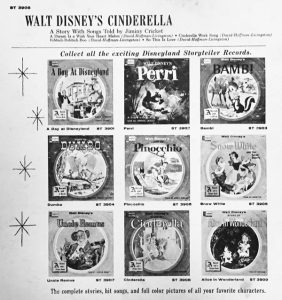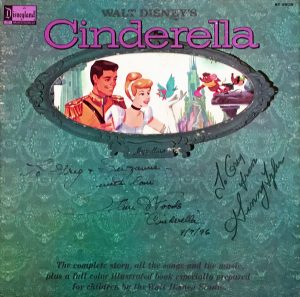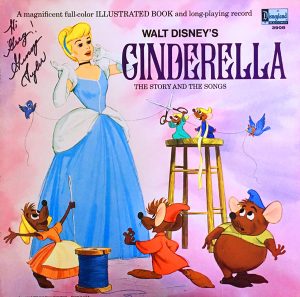In celebration of the film’s 70th anniversary year, here’s a look at five Cinderella story albums–all as lovely as their name–from Disneyland Records between 1957 and 1980.

Walt Disney’s Story of CINDERELLA
Told by Cliff Edwards as Jiminy Cricket
Disneyland Records – Storyteller Series ST-2001, (10” 33 1/3 RPM with Gatefold / Mono)
LP Reissue: ST 3908 (12” 33 1/3 RPM with Book / Mono)
Originally Released in 1957, reissued in January 1958. Executive Producer: Jimmy Johnson. Producer: Tutti Camarata. Musical Direction: Oliver Wallace, Paul J. Smith. Running Time: 21 minutes.
Walt Disney’s Story of CINDERELLA
Told by Ginny Tyler as the Disneyland Storyteller
Disneyland Records – Storyteller Series ST-3908 (12” 33 1/3 RPM with Book / Mono)
Released in January 1960, reissued in 1969. Executive Producer: Jimmy Johnson. Producer: Tutti Camarata. Running Time: 19 minutes.
Walt Disney’s Story of CINDERELLA
Disneyland Records – Storyteller Series #3908 (12” 33 1/3 RPM with Book / Mono)
Released in 1980. Producer: Jymn Magon. Running Time: 29 minutes.
Speaking Voices (1980): Linda Gary (Narrator, Stepmother, Drizella); Patty Parris (Cinderella, Anastasia); Tony Pope (Jaq, Duke, Page); Corey Burton (Gus, King, Prince).
Singing Voices (all versions): Ilene Woods (Cinderella); Jimmy Macdonald (Jaq, Gus); Verna Felton (Fairy Godmother); Mike Douglas (Prince); Norma Zimmer (Soloist).
Songs (all versions): “Cinderella,” “A Dream is a Wish Your Heart Makes,” “Bibbidi-Bobbidi-Boo (The Magic Song),” “So This is Love” by Al Hoffman, Mack David, Jerry Livingston.
 Jiminy Cricket might seem an unusual choice to narrate the story of Cinderella. However, with his acceptability as a sideline participant in almost any story as well as Cliff Edwards’ sincere communicative skills, he could easily have narrated any Disneyland Storyteller album.
Jiminy Cricket might seem an unusual choice to narrate the story of Cinderella. However, with his acceptability as a sideline participant in almost any story as well as Cliff Edwards’ sincere communicative skills, he could easily have narrated any Disneyland Storyteller album.
In his Cinderella context, Jiminy recounts the tale as if he tagged along. As in Pinocchio, he is characteristically informal–in this case, he refers to Cinderella’s stepsisters as “Stash” and “Driz.”
The first time this record was released was in 1957, when the movie was reissued to theaters for the first time. The original ten-inch album contained no book, just a tri-fold cardboard cover with a ten-inch LP record. The liner notes on this issue, by the way, incorrectly identify the voice of the Prince as Don Barclay—the singing is done by Mike Douglas, best known as a daytime talk show host and also the first co-host (with Joan Lunden) of the Walt Disney World Christmas Day Parade broadcast.
A short-lived format, ten-inch LPs were offered a transition of sorts from 78 RPM albums to 33 1/3 RPM single discs, with just enough running time (about 20 minutes) to fit the contents of a three- or four-disc 78 set on to one 33 platter. When the twelve-inch LP become the norm, many record companies, like Decca and Columbia, often piggybacked two earlier 78 albums on one LP disc because 20 minutes was too short for most pop, show and classical LPs.
Children’s records (and budget LP’s) were a different story, though. There were quite a few Disneyland albums that ran less than 20 minutes and no one seemed to mind very much. The Cinderella story record, having originated as a 10-inch record, was simply remastered as a larger disc without adding time. The Jiminy Cricket version sold for two years and was reissued for an educational LP release in 1970 (which you will see below).
 In 1960, the Disneyland Records division was in the midst of trimming production costs. Annette’s records were keeping things afloat, and the early soundtracks were rebounding after being repackaged as children’s LPs rather than mainstream show albums. The Storyteller series had started in 1957, combining music from Disney classics with narration primarily by Jiminy Cricket and various Mickey Mouse Club Mouseketeers. Now that the TV series was off ABC and would not be seen in syndication until 1962, the Storytellers were being revised and repackaged.
In 1960, the Disneyland Records division was in the midst of trimming production costs. Annette’s records were keeping things afloat, and the early soundtracks were rebounding after being repackaged as children’s LPs rather than mainstream show albums. The Storyteller series had started in 1957, combining music from Disney classics with narration primarily by Jiminy Cricket and various Mickey Mouse Club Mouseketeers. Now that the TV series was off ABC and would not be seen in syndication until 1962, the Storytellers were being revised and repackaged.
For the new “Magic Mirror” Storyteller series—featuring die-cut windows on each cover to reveal some of the artwork inside—Disney Legend Ginny Tyler was dubbed the “Disney Storyteller” and rerecorded Snow White (see this Spin), Alice in Wonderland, Cinderella, Peter Pan and Bambi (see this Spin).
None of the scripts were changed in the transition. Tyler was given the originals to perform in her own style. However, her script of Cinderella was still told through the eyes of Jiminy Cricket. Perhaps in the interest of time, a decision was made for Tyler to play a generic cricket instead of rewriting the script. Other than that, she says everything that Jiminy says, even “Stash” and “Driz.” It doesn’t make much logical sense from a Disney character standpoint, but it all worked out because Tyler’s “cricket” version was a steady seller in retail stores and through direct mail for 20 years, ten times longer than the Edwards version.
 There was just one occasional snag. Sometimes the Disney pressing plant placed Jiminy Cricket versions in the Magic Mirror covers or the 1969 pink reissue covers. An issue of overstock, this was not a problem since neither cover identified the narrator. The real confusion occurred with “oddball” pressings in which Edwards was on one side and Tyler was on the other!
There was just one occasional snag. Sometimes the Disney pressing plant placed Jiminy Cricket versions in the Magic Mirror covers or the 1969 pink reissue covers. An issue of overstock, this was not a problem since neither cover identified the narrator. The real confusion occurred with “oddball” pressings in which Edwards was on one side and Tyler was on the other!
Both the Edwards and Tyler Cinderella albums presented narration between the songs but no soundtrack dialogue. In 1980, a completely new story recording was created from scratch. Producer Jymn Magon, who had spent the previous several years dramatizing the 7-inch read-along book-and-record sets, set upon a similar task with Cinderella. The original soundtrack dialogue must not have been licensed for records, so Magon’s stellar “stock company” recreated all the voices to match the rhythm and inflections of the film.
The background score was limited to what was available on the “DQ-1207” vinyl album that had just been given a new cover design that year. For some reason, additional material from the earlier “WDL” series soundtrack (see this Spin) must not have been accessible. Great ingenuity was used to artfully edit, rearrange and repeat the limited background cues to fit the action and give the album a rich, full orchestral feeling.
A Comparison Between Cinderella Storytellers
Three excerpts of the Fairy Godmother sequence from the four editions (one recording was released with two different covers) of the same Storyteller album, all with Disneyland catalog number #3908 except the original 10-inch LP record, which was ST-2001. The voice of the Fairy Godmother is uncredited. She sounds very familiar, like Nedra Volz, Amzie Strickland or Billie Bird, but conclusive data is unavailable at this time.

Cinderella Listening Story Lesson Excerpt – Parents & Stepparents 1970
In 1970, Walt Disney Educational Materials Company, also known as WDEMCO—a related division of Disneyland Records—packaged several classic Disney Storyteller albums for school use. Teaching guides were added to the illustrated books and extra material was recorded for the end of the records. Eight extra minutes were added to Cinderella to discuss the negative image of stepparents in fairy tales, providing outstanding positive examples from history and entertainment including George Washington, Abraham Lincoln, Josephine Baker, Bob Hope, Roy Rogers and Dale Evans.


 GREG EHRBAR is a freelance writer/producer for television, advertising, books, theme parks and stage. Greg has worked on content for such studios as Disney, Warner and Universal, with some of Hollywood’s biggest stars. His numerous books include Mouse Tracks: The Story of Walt Disney Records (with Tim Hollis). Visit
GREG EHRBAR is a freelance writer/producer for television, advertising, books, theme parks and stage. Greg has worked on content for such studios as Disney, Warner and Universal, with some of Hollywood’s biggest stars. His numerous books include Mouse Tracks: The Story of Walt Disney Records (with Tim Hollis). Visit 





















































When the HBR (Hanna-Barbera) records disappeared from the stores, I turned my interest to the Disneyland Storyteller albums. My first one was “Winnie the Pooh and the Honey Tree,” which featured all of the character voices, so it was a good transition from the excellent voice work of the HBR albums. My second one was Ginny Tyler’s narration of “Snow White and the Seven Dwarfs” which was in the more standard format of the time in which a solo narrator told the story supplemented by songs from the original sound track. That said, by the time I heard the Ginny Tyler “Cinderella” album I was accustomed to hearing her as narrator, but was puzzled by her “cricket” characterization. It seemed irrelevant to have a lady cricket telling the story of Cinderella. Since the story itself was intact, and the cricket character wasn’t very obtrusive, I didn’t puzzle over it too much, but it always seemed a little odd. Only years later did I learn that Ginny Tyler’s version was a re-recording of an earlier version featuring Jiminy Cricket. Knowing that, I found that Ginny’s version made more sense. By the time the Linda Gary version was released, I was in college and had moved onto other things, so I never came across it until many years later, after I had discovered the Jiminy Cricket version. Of the three, while each has its unique charms, the version I have come to prefer the most is the one with Jiminy Cricket’s narration. There will never be anyone who can deliver the warmth and charm of Cliff Edwards as the original voice of Jiminy Cricket.
Thanks for your post Greg.
I received my first Magic Mirror record of Cinderella in 1960. The cut out mirror had a clear plastic window and the pages inside were small half pages. The narration was Jiminy Cricket. From my observation all of the Magic Mirrors from the 1960 release contained the original narrators from the 1957 circle covers. In 1962 the plastic from the Magic Mirror was removed the inside pages became full size (the half pages were probably not very kid friendly) and Ginny Tyler became the narrator. The original narrators (Jiminy Cricket, Annette, Jimmy Dodd, Darlene) had score music under the narration which was not replicated on the Ginny Tyler versions. I’ve always preferred the original narrators as they usually reflected the stories they were telling. For example Annette telling Snow White and Darlene telling Alice in Wonderland and using her vocals. It seems that some of this info is not chronicled elsewhere.
Hi Daniel,
It’s nice to get your comments, thank you!
There never seemed to be any logic to the way the pressing plant stocked the records in relation to the covers and books. The Alice in Wonderland I first got was a Magic Mirror with no plastic and it had a Darlene record inside. I bought another Magic Mirror with a different kind of gatefold cover (the “unipak” lighter cardboard) and one side was Ginny Tyler with Darlene on the other. I have a 1969 purple cover Snow White with the Annette narration.
Here is my guess on the reason. When Disneyland Records launched each new cover and package, they destroyed all earlier ones at the pressing plant and placed the remaining records, regardless of who narrated them, into the new covers. There was no narrator listed on any of the Ginny Tyler Magic Mirrors so there would be no conflicting information (the earlier ones named the narrators).
Any oddball discs with the wrong narrators on one side or the other were simply shipped by mistake for the same reason. The staff couldn’t tell the difference because no narrator was listed. “Oddball” pressings happened once in a while in the record days and I’m sure some people collect them. I once got a copy of the Broadway cast of Annie with a disco group on sid two.
George Washington: the first president, first in war, first in peace, and first in the hearts of his countrymen. But he married a widow! Moral: You can’t always be first.
That’s a lovely homily on parents and stepparents from the 1970 record. It’s quite dated now, when step-families have become very common, if not the norm; but it reflects a view of education as fundamentally character-building, beyond imparting information and life skills.
I’m surprised to learn about the pressing errors that sometimes occurred in the manufacture of these records. That never happened with classical LPs. If RCA had mistakenly pressed an Elvis Presley song on one side of a Toscanini recording, there would have been legal action — most likely led by the maestro himself.
Happy 70th, Cinderella! May we never stop believing that our dreams will come true.
As a kid I had the oddball pressing and I always wondered what happened to Jiminy on side two. After almost 60 years, I now know. Thank you, Greg!
Thank you for posting this. Extremely enlightening, especially to such a voracious Disney Records aficionado as I. I grew up on the Ginny Tyler storyteller albums, and this post really helps to fill in a lot of holes in my bank of knowledge. My first ever Disney souvenir was the storyteller album of “101 Dalmatians” which I bought (as a 7 year-old tot) at Walt Disney World the year that it opened. I came to the “Cinderella” album later (and was always puzzled at the seemingly unnecessary detour of Tyler as a cricket), but was delighted by her rendition. The history you’ve provided really helps clarify things. I also had the Ginny Tyler “Snow White” purple storyteller album which I knew by heart. I was always a particular fan of the four Oz story tellers (including “The Scarecrow of Oz,” “The Tin Woodman of Oz” and “The Cowardly Lion of Oz” as well as “The Wizard of Oz” — all of which featured Ginny Tyler and Robie Lester significnatly. I would love to know more on these, historically as well. Any chance of further postings to feature these?
Loved your “Mouse Tracks” books, too, BTW.
I read quite a while ago in R. Michael Murray’s book ”The Golden Age Of Walt Disney Records”, that some of the ”WDL 4000 series” (the first pressings of the soundtrack albums which were superior to the later ones, and pitched to adult audiophiles””) were disposed of in the same way, when the cheaper ”Disneyland” label launched it’s kid-friendly $1.98 soundtrack line. They simply put some of the remaining high quality pressings in the new covers, despite the price drop. I don’t know about ”Cinderella” or any of the others, but, ”Snow White” was definitely one of them. I saw a copy myself, and occasionally, one will surface on EBAY, in the later cover. According to Murray, the same thing happened with ”Alice In Wonderland”, which, (in it’s original cover,) is going fore more than $1,000 on EBAY, right now.
Hi Greg! Also in Italy we had the Cinderella LP record, first issued in 1965 with the “round cover” but no booklet. In 1968 a Magic Mirror version was issued and then, in 1970/71 the normal Storyteller with painted figures booklet and pink cover. In all these editions the recording was the same (no narrator) but insted we had a recording of the actual optical soundtrack of the film in its italian version. The funny thing is that the film was redubbed in Italy for its 1967 reissue and the record was never changed (it was reprinted until 1988 and subsequently even redone on CD! So when you went to the cinemas you listened to the new dubbing and at home you could listen to original 1950 italian voices. Ww always had the curiosity to listen to the parts of dubbing that were cut in the record. What a pity it seems that this old dubbing is not to be found on disney archives, it could be fun to put it on disney plus as second italian audio choice!